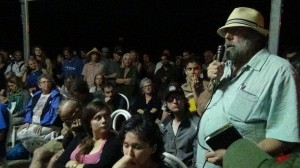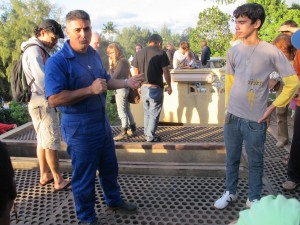La segunda parte de la IPC fue la Convergencia, que tuvo lugar en el beach resort "Los Cocos". En grupos de cinco o seis personas, fuimos acomodados en bungalows equipados con sencillez pero con todo lo suficiente para satisfacer nuestras necesidades. El programa se desarrolló con fluidez tras algunos cambios en los horarios y la organización. Se realizaron presentaciones simultáneamente en cinco espacios diferentes, así como varias actividades al aire libre para profundizar en los debates. El menú cubano consistió en grandes cantidades de congri (una mezcla de arroz y frijoles), pollo, pescado, tupinambo, col y salsa de guayaba. El programa contaba con literalmente cientos de oradores, de modo que resultó imposible retener todo el aprendizaje y los recursos que se ofrecieron. En total 423 personas participaron en la convergencia.
Vídeo: Qué cosecharon los participantes en la Convergencia
Artículo sobre La Conferencia aquí. Artículo breve sobre Cuba aquí.
A continuación, una selección de algunos de los momentos más destacados de la Convergencia y el tour por La Habana.
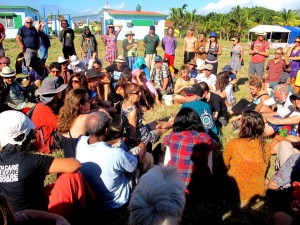
The second part of the IPC was the Convergence that took place at the beach resort “Los Cocos”. We stayed five or six people in each bungalow, sparsely equipped, but sufficient for our needs. Some organising and rescheduling of activities made the program run smoothly with five streams of presentations and several open spaces for deeper discussions. Cuban food was on the menu with generous portions of congri (a mix of rice and beans), chicken, fish, yams, cabbage and guava sauce.
Literally hundreds of speakers were on the program, so it was impossible to retain all the learning and resources that was given. In all 423 people attended the convergence.
Video: What people harvested from The Convergence
Read about The Conference here. For an extremely short introduction to Cuba click here.
Keep reading about a few selected highlights of The Convergence and Havana tour beneath.
Permacultura y capitalismo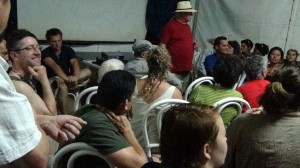
Un acalorado debate iniciado por Scott Pittman y centrado en el tema "Permacultura y capitalismo" fue uno de los momentos de mayor controversia. Cuestiones como si "está permitido" que los permacultores ganen dinero y se hagan millonarios gracias a su trabajo en permacultura o deberían ser anticapitalistas puristas (o algo intermedio), sacaron a la luz varios dogmas subyacentes a la cultura de la permacultura.
¿Qué es el capitalismo y qué maneras de usar el dinero son positivas? No hubo una respuesta a esta pregunta, pero varias intervenciones ayudaron a esclarecer qué formas de ganarse la vida son aceptables en permacultura. Por ejemplo, el concepto de "permacultores millonarios" sería más aceptable para la mayoría si se trata de cooperativas y no de individuos.
Estándares en la enseñanza de la permacultura
Otro acalorado debate, facilitado también por Scott Pittman con la participación de varias superestrellas de la permacultura trató sobre "la permacultura y los estándares de enseñanza". Las opiniones de un extremo del espectro consideraban que el currículo original de Bill Mollison es "sagrado", con su énfasis en el mundo natural y la "alfabetización ecológica" como aspecto central de la permacultura. El otro extremo del espectro contemplaba la enseñanza de la permacultura como una manera de crear emprendedores éticos que aplican todos los principios pero no tienen contacto alguno con las plantas.
Los profesores más jóvenes pusieron sobre la mesa la cuestión de qué esperan los profesores más experimentados de los nuevos profesores y si el currículo del CDP está empezando a quedar anticuado. La generación más joven está explorando el campo de la permacultura e identificando subsecciones que se centran solo en la permacultura social o en las tecnologías apropiadas, manteniendo la consideración de que las éticas, los principios y el diseño son la esencia. A estos profesores les gustaría ver más diversidad en el movimiento, y no menos; la idea es que la enseñanza tiene que evolucionar junto con el movimiento.
Las personas y la permacultura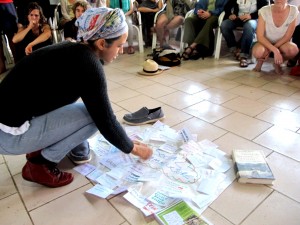
Se dedicó mucho tiempo a hablar sobre las personas en la permacultura, de las "estructuras invisibles" de organización y gestión y del carácter pedagógico, participativo y activo de la enseñanza de la permacultura. Entre algunos de los defensores de la permacultura social estuvieron Robin Clayfield, Starhwak y nuestro Peter Cow.
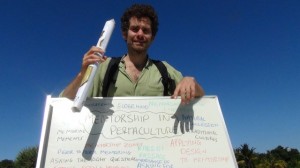 En las palabras de Eric Toensmeier, de los Estados Unidos, "las cosas más apasionantes que están sucediendo hoy en día en la permacultura no tienen que ver tanto con las plantas, porque ya tenemos muy trabajada esa área, y el movimiento y la creación de comunidad son los campos donde ahora mismo se está avanzando más". Algunas afirmaciones en la línea de la importancia de la permacultura social fueron: "Nunca he visto una comunidad que fracase por poner las plantas en el lugar equivocado. Donde generalmente fallamos en aspectos invisibles como los procesos y los problemas subyacentes, las cuestiones de poder y privilegio, que están detrás de las maneras en que trabajamos juntos... o no trabajamos."
En las palabras de Eric Toensmeier, de los Estados Unidos, "las cosas más apasionantes que están sucediendo hoy en día en la permacultura no tienen que ver tanto con las plantas, porque ya tenemos muy trabajada esa área, y el movimiento y la creación de comunidad son los campos donde ahora mismo se está avanzando más". Algunas afirmaciones en la línea de la importancia de la permacultura social fueron: "Nunca he visto una comunidad que fracase por poner las plantas en el lugar equivocado. Donde generalmente fallamos en aspectos invisibles como los procesos y los problemas subyacentes, las cuestiones de poder y privilegio, que están detrás de las maneras en que trabajamos juntos... o no trabajamos."
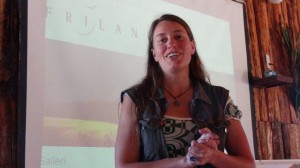 Presentación del EPT en la IPC
Presentación del EPT en la IPC
La convergencia estuvo repleta de presentaciones, pero una selecta delegación del EPT compuesta por Kipper, Hugo Oliviera, Peter Cow y Cathrine Dolleris dispuso de un espacio de tiempo para compartir el funcionamiento del EPT. Se explicaron los objetivos y la estructura del proyecto, así como el VSM (Modelo de Sistemas Viables). Un pequeño pero interesado grupo asistió a la presentación, entre ellos Robyn Francis, quien se declaró impresionado y celoso de nuestras capacidad de conseguir financiación para organizar partenariados internacionales en Europa.
Futuras IPC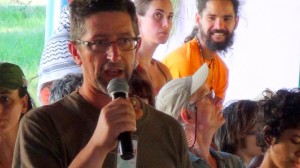
Durante el cierre de la Convergencia, Andy Goldring nos recordó a todos que la próxima IPC tendrá lugar en 2015 en el Reino Unido, tal vez a principios de septiembre. Andy esbozó algunas de las ideas, entre ellas la voluntad de darle un enfoque europeo, los planes de que parte de la conferencia se celebre en Londres (con el apoyo de la gran comunidad de couchsurfers), y la convergencia en el campo con alojamiento en campings, así como numerosos tours por el Reino Unido. También sugirió que podría haber muchos talleres, cursos y eventos relacionados (fringe) antes y después de la IPC con el fin de que los participantes puedan aprovechar lo mejor posible su estancia en Europa.
Durante la convergencia se decidió que la siguiente IPC (en 2017) tendrá lugar en la India. En 2013 solo unas pocas personas de toda Asia asistieron a la convergencia, lo cual indica claramente que es una región que necesita el empuje que le brindará la celebración de una IPC. También se contempló América del Sur como posible anfitriona de la IPC en 2017, pero se consideró que Asia era una mejor opción.
 Lavado de coches permacultural
Lavado de coches permacultural
¿Alguna vez oíste hablar de un Lavadero de coches permacultural? Bueno, los participantes en la IPC que veníamos de fuera de Cuba tampoco, hasta que llegamos al lavadero de Paolo en Patio de la fe. Los cubanos adoran sus enormes coches, esos modelos cromados americanos de los años cincuenta. Muchos de estos coches funcionan como taxis en toda Cuba, transportando a hasta 7 u 8 personas apretadas, y el humo de los tubos de escape llena las ciudades. Sí, enseguida surge la pregunta: ¿cómo puede un lavadero de coches ser permacultural? Reciclar el agua, extraer el aceite y las sustancias contaminantes y reinvertir el dinero en el negocio y en el huerto ecológico son parte de la solución.
El lavadero utiliza un sistema de filtrado donde el agua retenida se acumula en una zanja hasta que el aceite sube a la superficie y se puede retirar fácilmente y llevar a una planta de reciclaje. El agua pasa por gravedad a través de un filtro mecánico y siete filtros biológicos y recipientes consecutivos para su limpieza, antes de ser bombeada de nuevo a un tanque con agua para el lavado. El agua filtrada no es potable pero está lo suficientemente limpia como para lavar más coches. Ciertamente, el pensamiento creativo forma parte de este diseño, algo que nos invita a abrir nuestras mentes más allá de los patrones habituales.
El EPT en Jagüey Grande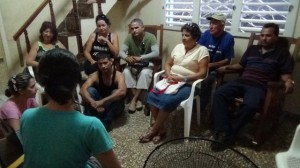
Peter Cow y Cathrine Dolleris tuvieron el honor de presentar la permacultura europea y el proyecto EPT a un grupo de permacultores en el pequeño pero imponente pueblo de Jagüey Grande, situado en la provincia de Matanzas. 10 permacultores locales asistieron a la presentación, en las que se les explicó el funcionamiento del EPT, con la proyección del bonito film realizado por Mihail Kossev durante el encuentro en Portugal. La presentación fue muy bien recibida.
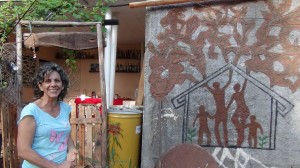 Por lo general, los permacultores locales en Cuba están ávidos de información, puesto que allí el acceso a Internet es prácticamente imposible y los ordenadores no abundan. Estuvimos encantados de compartir un montón de recursos digitales con nuestros anfitriones.
Por lo general, los permacultores locales en Cuba están ávidos de información, puesto que allí el acceso a Internet es prácticamente imposible y los ordenadores no abundan. Estuvimos encantados de compartir un montón de recursos digitales con nuestros anfitriones.
Fue una gran experiencia. Aquellos con planes de viajar, bien podrían ir a Cuba y pasar un tiempo con la encantadora pareja Juliet y Rogelio (teléfono 0053 52940801, de momento no disponen de correo electrónico). Ellos estarán encantados de recibirlos y conectarlos con la red local de permacultores de Jagüey Grande, unos 120 km al sur de La Habana. Su casa está a 35 km de la Bahía de Cochinos, de triste fama y una gran belleza, con sus asombrosos arrecifes de coral donde se practica el buceo y el esnórkel, y es uno de los mejores lugares para disfrutar de la fauna y flora cubana y la observación de aves.
Puedes leer un artículo breve sobre Cuba aquí.
[gallery ids="1932,1933,1934,1935,1936,1937,1938,1939,1940,1941,1942,1943,1944,1945,1946,1947,1948,1949,1950,1951,1952,1953,1954,1955,1956"]Permaculture and Capitalism
A heated discussion initiated by Scott Pittman was amongst the more controversial, focussing on “Permaculture and Capitalism”. Statements around whether permies are “allowed” to make money and become millionaires from doing permaculture work or be purist anti-capitalists (or something in between) brought forward underlying dogmas about permaculture culture.
What is capitalism and what are the good ways of using money? This question was never answered but several contributions helped to clarify permaculture’s possible acceptable livelihoods. For example the concept of “Permaculture millionaires” would be more palatable to most people as cooperatives rather than individuals.
Permaculture teaching standards
Another heated discussion, also facilitated by Scott Pittman with participation of several permaculture superstars was about “Permaculture and standards in teaching”. One end of the spectrum of opinions regarded Bill Mollison’s original permaculture curriculum as being “sacred” with its emphasis on the elements of the natural world and ecoliteracy being at the heart of permaculture. The other end of the spectrum was teaching permaculture to create ethical business people using all the principles but without ever looking at a plant.
Voices from young teachers raised the question about what the elders expect from new teachers and whether the PDC is starting to be outdated. The younger generation is exploring the field of permaculture and finding new subsections of permaculture focussing only on social permaculture or appropriate technology while still holding true to the ethics, principles and designs as essential. They want to see more diversity in this movement, not less – meaning that education needs to evolve with the movement.
People and Permaculture
A lot of emphasis was put on people and permaculture, both as the “invisible structures”, organisation and management; and the pedagogical participatory and engaged approach to teach permaculture. Proponents of social permaculture present were amongst others Robin Clayfield and Starhawk and our own Peter Cow.
 As Eric Toensmeier, US, said, “The real exciting things that are happening in permaculture right now aren’t so much about the plants, because we’ve got a lot of that worked out, but the movement and community building is really where the cutting edge is happening at the moment.”
As Eric Toensmeier, US, said, “The real exciting things that are happening in permaculture right now aren’t so much about the plants, because we’ve got a lot of that worked out, but the movement and community building is really where the cutting edge is happening at the moment.”
Supporting the case for more emphasis on social permaculture were also statements like: “I’ve never seen a community fall apart because they put their plants in the wrong place. Where we generally fail is in the invisible areas of what are the underlying processes and issues, power and privilege which inform the way we work together – or don’t work.”
 Presentation of EPT at the IPC
Presentation of EPT at the IPC
The convergence was tightly packed with presentations, but a select delegation consisting of Kipper, Hugo Oliviera, Peter Cow and Cathrine Dolleris got a slot of time to share the workings and wonders of the EPT. The aims and meeting structure was explained as well as the VSM. A small but keen crowd attended the presentation, including Robyn Francis, who was impressed and jealous of our ability to get funding and to organise international partnerships in Europe.
Future IPCs
At the close of the Convergence, Andy Goldring reminded everyone that the next IPC will be in 2015 in the UK (perhaps in early September?). He outlined some of the ideas, including a focus on Europe wide permaculture, plans to run part of the conference in London (supported by epic couch surfing), a large camping based convergence in the countryside, and lots of tours around the UK. He also suggested that there could be plenty of fringe workshops, courses and events before and after the IPC so participants can make the most of their time in Europe.
It was decided at the convergence that the following IPC (in 2017) would be in India. There was only a handful of people at the 2013 IPC from the whole of Asia, so this is clearly a region that needs the boost that hosting an IPC will bring. South America was keen to host the IPC in 2017 as well, but India was judged the best.
 Permaculture carwash
Permaculture carwash
Have you ever heard of a Permaculture Carwash ? Well, neither had we, the IPC travelling permies, before we visited Paolo’s carwash in Patio de la Fe. They love their cars in Cuba, huge, antique chrome-and-fin 1950s US cars. They work as taxis all over Cuba, squeezing up to 7 or 8 people in, and their big, smoky exhaust fumes fill the cities.
Yes, the question immediately arises – how can a carwash be permaculture?
Recycling the water, capturing oil and pollutants and reinvesting money back into the business and organic garden was part of the solution.
The carwash had a filtering system, where the water captured was resting in a ditch until the water was so still that the oil flowed on top and could then easily be skimmed off the surface and taken to a recycling place. The water passed through a mechanic filter and seven successive biological filterings and cleaning recipients using gravity before being pumped back into a tank with water for the carwash. The water was good enough for washing more cars, but not for drinking.
Creative thinking was certainly part of this design, something that could stretch our minds beyond their habitual patterns.
EPT in Jaguey Grande
Peter Cow and Cathrine Dolleris had the honour of presenting European permaculture and the EPT to a group of permaculturistas in the small but proud provincial town of Jaguey Grande in Matanzas province. 10 local permies were introduced to the work of the EPT using Mihail Kossev’s great movie from Portugal as a highlight. It was very well received!
 Local permies in Cuba are generally very information hungry as internet access is nearly impossible and computers are rare. We were happy to share a lot of digital resources with our permie hosts.
Local permies in Cuba are generally very information hungry as internet access is nearly impossible and computers are rare. We were happy to share a lot of digital resources with our permie hosts.
It was a great experience! If you plan a trip abroad, go to Cuba and spend time with the lovely couple Juliet and Rogelio (telephone 0053 52940801, no email address currently). They will be delighted to host you and connect you with the local network of permies in Jaguey Grande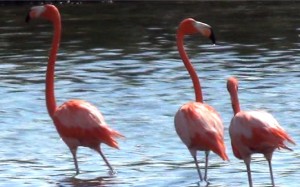 about 120 km southeast of Havana. Their house is 35km from the infamous, and very beautiful “Bay of Pigs” (Bahia de Cochinos), which has awesome diving and snorkelling on coral reefs, and is one of the best places to birdwatch and see wildlife in Cuba.
about 120 km southeast of Havana. Their house is 35km from the infamous, and very beautiful “Bay of Pigs” (Bahia de Cochinos), which has awesome diving and snorkelling on coral reefs, and is one of the best places to birdwatch and see wildlife in Cuba.
For an extremely short introduction to Cuba click here
[gallery ids="1932,1933,1934,1935,1936,1937,1938,1939,1940,1941,1942,1943,1944,1945,1946,1947,1948,1949,1950,1951,1952,1953,1954,1955,1956"]
- Log in to post comments

